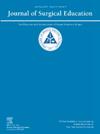Rapid Cycle Deliberate Practice With Spaced Training Achieves Comparable Results in Achieving Simple Laparoscopic Skills to Traditional Weekly Training and Saves Time
IF 2.1
3区 医学
Q1 EDUCATION, SCIENTIFIC DISCIPLINES
引用次数: 0
Abstract
Objective
To compare the effectiveness of a traditional weekly simulation-based training model versus a program combining Rapid Cycle Deliberate Practice (RCDP) with spaced learning for the acquisition of intracorporeal simple suture skills in medical students.
Design
Prospective quasi-experimental pilot study with block randomization. Students were grouped in blocks of 4 based on scheduling availability. Within each block, participants were randomly assigned to the intervention (RCDP with spaced learning) or control (traditional weekly training group). All participants received 4 sessions of laparoscopic simulation training and were assessed using blinded video evaluation. OSATS (Objective Structured Assessment of Technical Skills) and GRC (Global Rating Checklist) scores were compared using t-test or Mann–Whitney U test, pass/fail outcomes with chi-square or Fisher’s exact test, and procedure time–OSATS associations with Spearman’s correlation.
Setting
The study was conducted at a tertiary teaching hospital in Ecuador, between October and December 2024.
Results
Thirty-eight students completed the study. No statistically significant differences were found between the intervention and control groups in OSATS scores: intervention: median 13, IQR 9–15; control: median 12.5, IQR 10–15.5; p = 0.889) or in Global Rating Checklist (GRC) scores; intervention: median 12, IQR 8.75–16; control: median 11.5, IQR 8–15; p = 0.890). Time metrics for individual tasks and overall procedure time were also comparable between groups (p > 0.3). Significant negative correlations were observed between total procedure time and OSATS performance scores in both groups, indicating that faster completion was associated with higher technical performance.
Conclusions
The combination of Rapid Cycle Deliberate Practice and spaced learning yielded comparable performance to a traditional weekly training model, despite a significant reduction in tutor-guided time and hands-on intracorporeal suture training. These findings support the potential of this approach as a viable and resource-efficient teaching alternative for basic laparoscopic skills, particularly under conditions of increased retention demand. Further studies are needed to evaluate its applicability to more complex procedures and its impact on long-term skill retention
与传统的每周训练相比,快速循环有意识的间隔训练在实现简单腹腔镜技能方面取得了相当的效果,并节省了时间
目的比较传统的每周模拟训练模式与快速循环刻意练习(RCDP)与间隔学习相结合的方案在医学生体内简单缝合技能习得中的效果。设计前瞻性准实验先导研究,随机分组。根据课程表的可用性,学生们被分成四组。在每个分组中,参与者被随机分配到干预组(间隔学习的RCDP)或对照组(传统的每周训练组)。所有参与者接受4次腹腔镜模拟训练,并采用盲法视频评估。使用t检验或Mann-Whitney U检验比较OSATS (Objective Structured Assessment of Technical Skills)和GRC (Global Rating Checklist)得分,使用卡方检验或Fisher精确检验比较合格/不合格结果,以及程序时间- OSATS与Spearman相关的关联。该研究于2024年10月至12月在厄瓜多尔的一家三级教学医院进行。结果38名学生完成了研究。干预组与对照组的OSATS评分差异无统计学意义:干预组:中位数13,IQR 9-15;对照组:中位数12.5,IQR 10-15.5;p = 0.889)或Global Rating Checklist (GRC)得分;干预:中位数12,IQR 8.75-16;对照组:中位数11.5,IQR 8-15; = 0.890页)。单独任务的时间指标和总体过程时间在两组之间也具有可比性(p >; 0.3)。在两组中,总手术时间和OSATS表现得分之间观察到显著的负相关,表明更快的完成与更高的技术表现相关。结论快速循环刻意练习和间隔学习相结合的效果与传统的每周训练模式相当,尽管导师指导的时间和实际的体内缝合训练显著减少。这些发现支持这种方法的潜力,作为一个可行的和资源高效的教学替代基本腹腔镜技能,特别是在条件下增加保留需求。需要进一步的研究来评估其对更复杂程序的适用性及其对长期技能保留的影响
本文章由计算机程序翻译,如有差异,请以英文原文为准。
求助全文
约1分钟内获得全文
求助全文
来源期刊

Journal of Surgical Education
EDUCATION, SCIENTIFIC DISCIPLINES-SURGERY
CiteScore
5.60
自引率
10.30%
发文量
261
审稿时长
48 days
期刊介绍:
The Journal of Surgical Education (JSE) is dedicated to advancing the field of surgical education through original research. The journal publishes research articles in all surgical disciplines on topics relative to the education of surgical students, residents, and fellows, as well as practicing surgeons. Our readers look to JSE for timely, innovative research findings from the international surgical education community. As the official journal of the Association of Program Directors in Surgery (APDS), JSE publishes the proceedings of the annual APDS meeting held during Surgery Education Week.
 求助内容:
求助内容: 应助结果提醒方式:
应助结果提醒方式:


